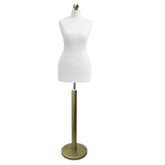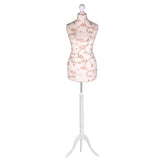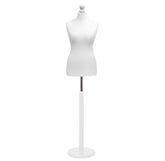Your Guide to Clothes Rail Wall Mounted Solutions
A clothes rail wall mounted is a fantastic storage solution that attaches straight to your wall. It frees up precious floor space and gives you a clean, minimalist way to hang your clothes. Think of it as the perfect tool for creating an open wardrobe, drying laundry, or finally taming that cluttered entryway.
Embrace Vertical Space with Wall Mounted Rails
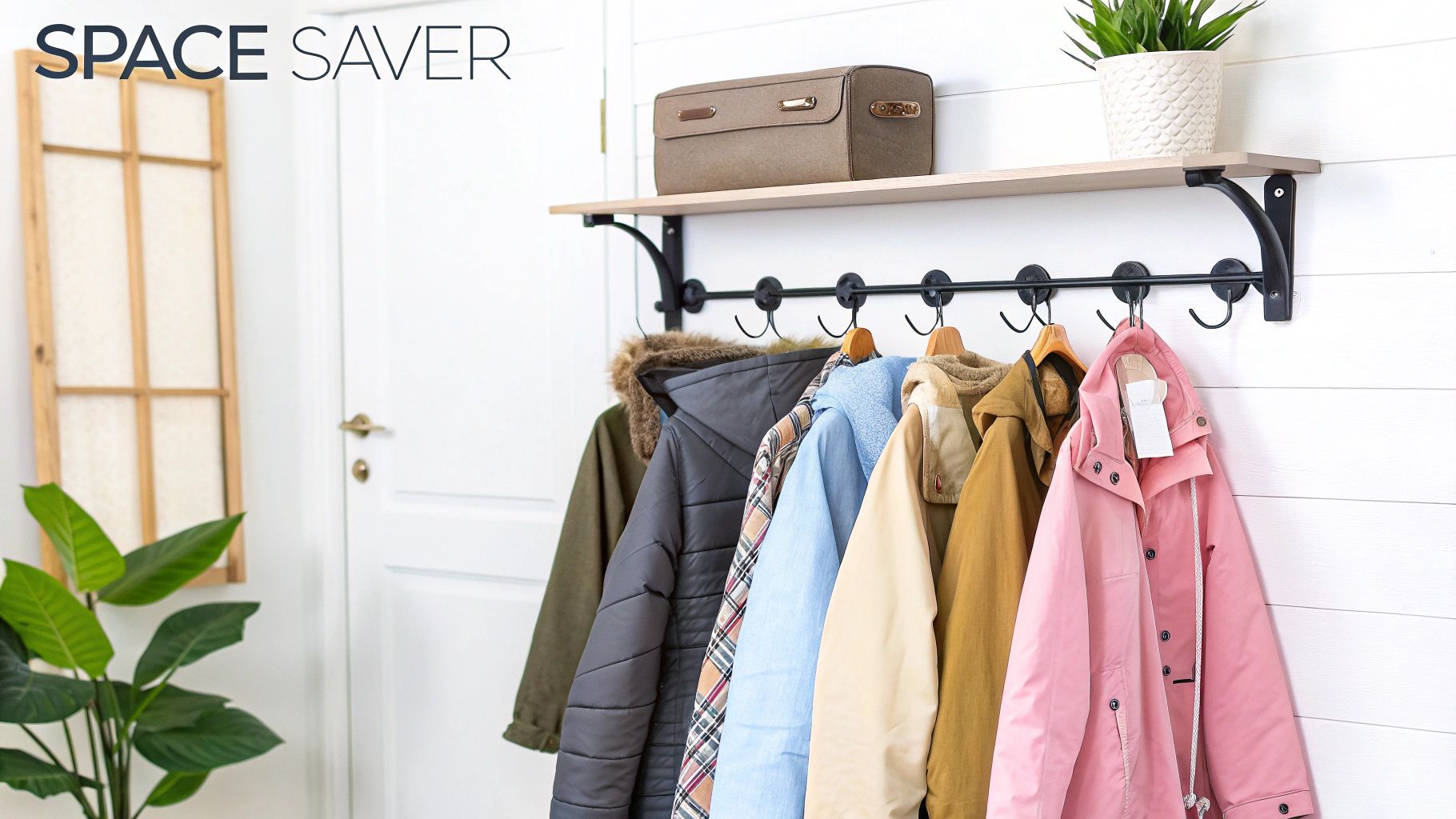
Staring at a cluttered floor and wondering where all the space went? The solution might be right in front of you—on your walls. Modern homes are all about smart, functional design, and the wall-mounted clothes rail is a prime example of this philosophy in action.
It’s not just a piece of metal; it’s a clever way to create an open, organised, and beautiful space. By making use of that often-ignored vertical real estate, these rails let you reclaim floor area that would otherwise be eaten up by a bulky wardrobe or a freestanding rack. This one simple change can make a room feel instantly bigger and less chaotic.
More Than Just Storage
The real genius of a wall-mounted rail is its sheer versatility. It does double duty, acting as both a stylish display for your favourite outfits and a practical spot for air-drying laundry. This flexibility makes it a must-have in so many areas of the home:
- In the Bedroom: It’s your new open-concept wardrobe, perfect for daily essentials or showing off a curated capsule collection.
- In the Hallway: It offers a sleek and tidy home for coats, scarves, and bags, keeping your entryway clear.
- In the Utility Room: It’s a sturdy, space-saving alternative to those clumsy drying racks, ideal for airing clothes indoors.
This move towards clever storage isn't just a fleeting design trend; it’s a response to how we live now. With urban living spaces getting smaller, the demand for smart, space-efficient solutions is on the rise. In fact, the global garment racks market was valued at around USD 5.2 billion in 2023 and is expected to grow even more.
By thinking vertically, you turn your walls from simple dividers into an active part of your home’s storage system. A well-placed rail doesn't just hold clothes—it helps organise your life and elevates your interior design. Learn more about effective clothes rail storage solutions in our detailed guide.
How to Select the Perfect Clothes Rail
Choosing the right wall-mounted clothes rail is a bit more involved than just picking a style you like. It's a practical decision that needs to match your space, your wardrobe, and crucially, your walls. Think of it like choosing tyres for a car—the wrong set might look fine, but they simply won't perform safely when things get serious.
Your starting point should always be two things: the material of the rail itself and the type of wall you're attaching it to. These two elements are completely linked; they'll determine how long the rail lasts, how much it can hold, and whether it stays put. A beautiful rail that can’t support your clothes isn’t a storage solution; it's just wall art.
Matching Materials to Your Style and Needs
The material of your clothes rail defines both its look and its strength. Since each option brings a different vibe to a room, you'll want to choose one that fits your interior design as well as the weight of your clothes.
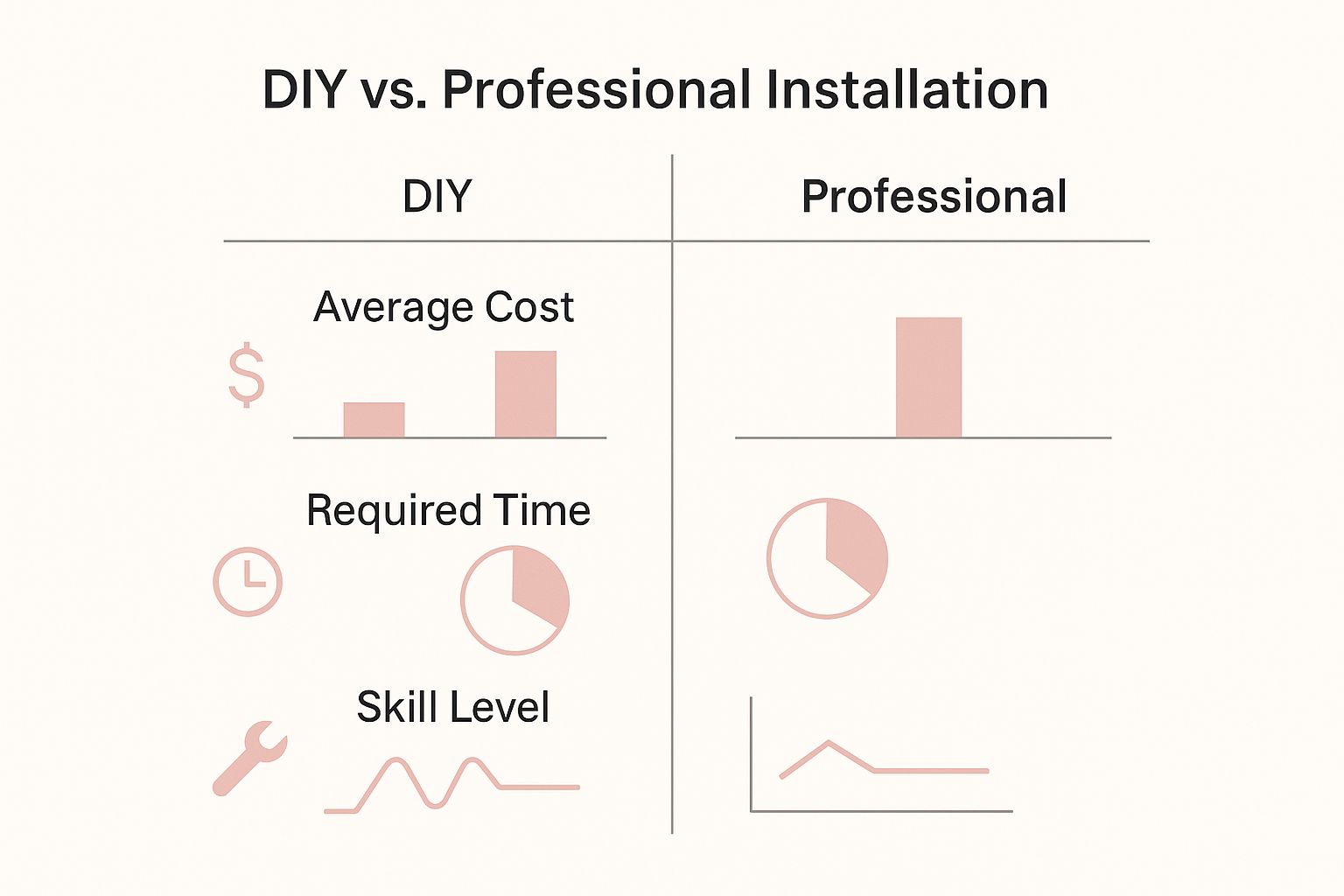
When it comes to materials, you've got a few great choices, each with its own character.
- Industrial Steel Pipe: This is your go-to for a raw, rugged look. It’s incredibly strong and fits perfectly into minimalist, urban, or industrial-themed spaces. It will happily take the weight of heavy winter coats and a full collection of clothes.
- Polished Chrome: For a clean, modern, and reflective finish, chrome is a classic. It works well in contemporary homes and gives off a retail-inspired feel. It’s plenty stylish, but always double-check the manufacturer’s specs for weight limits, as they can vary.
- Rustic Wood: Wood offers a warm, natural, and organic feel, making it ideal for Scandinavian or bohemian decor. While beautiful, it generally has a lower load capacity than metal, so it’s better suited for lighter items like shirts and dresses.
Let’s break it down to see how they stack up.
Comparing Clothes Rail Materials
Choosing the right material is a balance of aesthetics and practicality. This table should help you quickly see which option aligns best with your needs, from the look you want to the load you need it to handle.
| Material | Aesthetic | Typical Load Capacity | Best For |
|---|---|---|---|
| Industrial Steel | Raw, urban, minimalist | High | Heavy coats, large wardrobes, and making a bold design statement. |
| Polished Chrome | Modern, clean, reflective | Medium to High | Contemporary bedrooms, walk-in wardrobes, and retail-inspired displays. |
| Wood | Natural, warm, rustic | Low to Medium | Lighter garments like shirts and dresses; bohemian or Scandi-style rooms. |
Ultimately, the best material is one that not only looks the part but can also stand up to the demands of your wardrobe without compromise.
Understanding Your Wall Is Critical
This is non-negotiable. The single most important factor for a secure installation is knowing your wall type. A heavy-duty rail is completely useless if the wall it's attached to can't take the strain. Before you even think about buying, figure out what your walls are made of.
A clothes rail is only as strong as its connection to the wall. Using the wrong fixings for your wall type is the most common reason for installation failure, leading to potential damage and safety risks.
In most UK homes, you'll come across one of three main wall types:
- Plasterboard (Drywall): Very common in modern builds. You'll need specialised fixings like spring toggles or heavy-duty self-drilling anchors to spread the load. Never rely on standard screws and plugs alone.
- Solid Brick or Concrete: This is the gold standard. A secure fixing into solid masonry will give you the maximum possible weight capacity for your rail. It's as solid as it gets.
- Lath and Plaster: Often found in older properties, this type can be tricky. The best approach here is to find the wooden studs behind the plaster and fix directly into them for a secure hold.
If you have a lot of heavy items to hang, our article on choosing a clothes rail for heavy duty use has more in-depth advice. Getting the combination of rail, fixings, and wall right from the start means your new storage will be safe and reliable for years.
Installing Your Rail for Maximum Strength
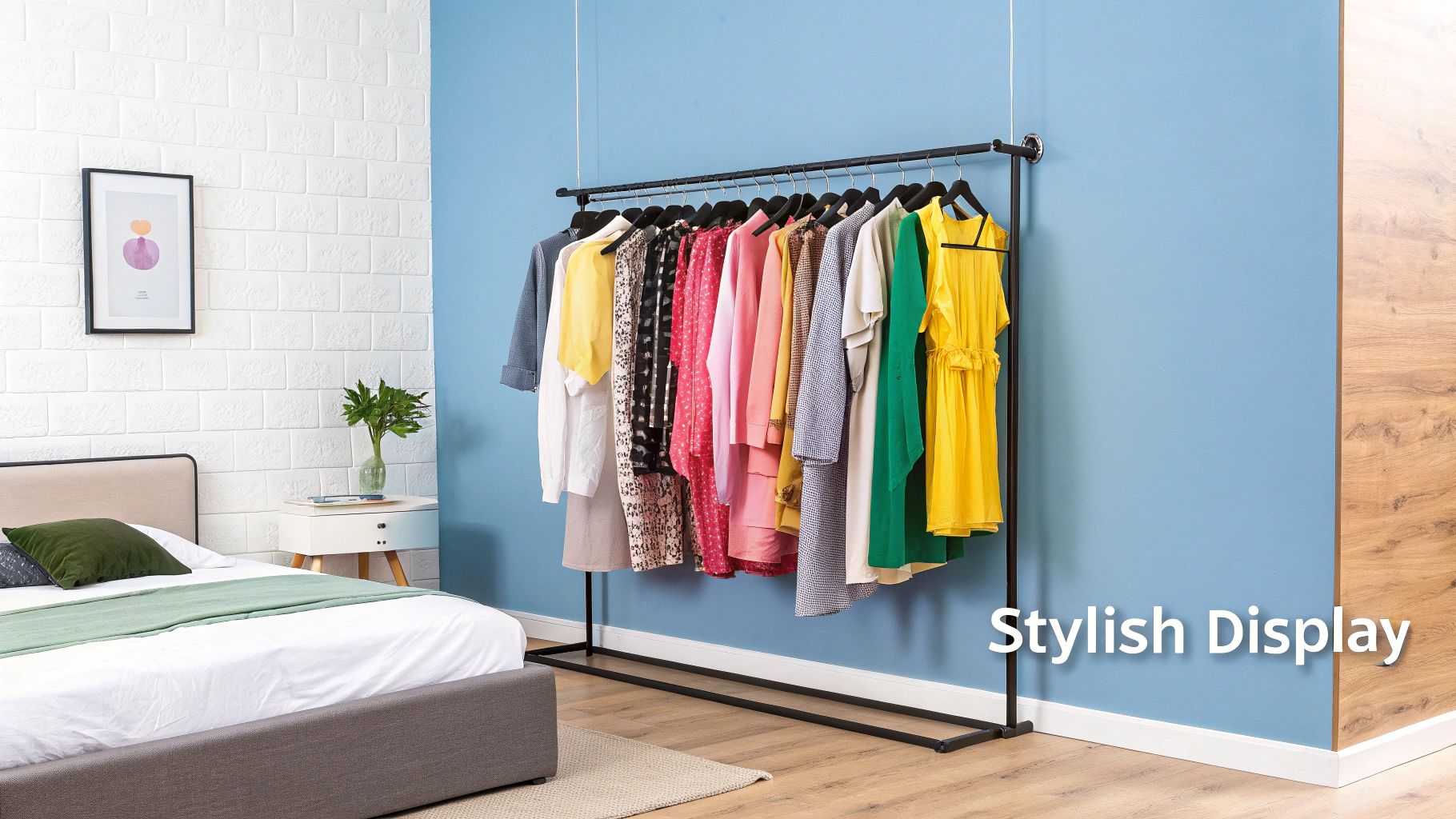
A wall-mounted clothes rail is only ever as good as its installation. Let’s be honest, a poorly fitted rail isn't just an eyesore; it's a disaster waiting to happen for your walls, your clothes, and anyone standing underneath. The good news is that getting a professional-quality, secure fit is completely achievable with the right approach and a little bit of care.
Think of it like hanging a heavy mirror. You wouldn't just tap in a single nail and hope for the best. The same logic applies here. The goal is to create a solid bond with the wall, one that can easily handle the weight of your entire wardrobe. This all comes down to finding the strongest points in your wall and using hardware that won’t let you down.
Preparing for a Secure Installation
Before you get anywhere near a drill, the first step is to get your tools in order. Having everything you need ready to go makes the whole job run smoothly and helps you sidestep those frustrating, common mistakes. You don't need a workshop's worth of gear, just a few essentials.
Here’s what your installation kit should look like:
- A Stud Finder: This is non-negotiable. It's your secret weapon for finding the hidden wooden beams behind plasterboard, which are by far the strongest anchor points.
- A Spirit Level: Eyeballing it never works. A spirit level is the only way to guarantee your rail is perfectly horizontal, stopping all your hangers from sliding down to one end.
- A Power Drill and Drill Bits: Make sure you choose a drill bit that’s just slightly smaller than the diameter of your screws. This creates a really snug and secure fit.
- A Pencil and Tape Measure: For marking your drill holes. Accuracy here is everything.
With your tools laid out, the next job is the most important one of all: figuring out what your wall is made of. This single detail will dictate your entire installation method.
Finding the Strongest Anchor Points
The golden rule for mounting anything heavy is to fix it directly into a wall stud whenever you possibly can. Studs are the vertical wooden frames that act as the skeleton of your wall, usually spaced about 16 inches apart. Fixing your clothes rail wall mounted brackets into these gives you a rock-solid connection that can take a serious amount of weight.
Grab your stud finder and scan horizontally across the wall where you want to hang the rail. Mark the edges of every stud it beeps over. This creates a clear map of the strongest spots available.
The most common reason installations fail is because the rail was attached directly to plasterboard. Plasterboard on its own is surprisingly brittle and simply can't hold heavy loads without proper reinforcement. Always aim for a stud.
What if the studs don't line up neatly with where you want the brackets? Don't worry, you have options. This is where heavy-duty plasterboard anchors come in. Specialised fixings like toggle bolts are designed to expand behind the board, spreading the load over a much wider area for a secure hold. For a deeper dive, you can check out our detailed guide on installing a wall mounted hanging rail.
Taking the time to mark your drill points properly, using a spirit level to draw a straight line, ensures your rail will be perfectly parallel to the floor. Follow these steps, and you're guaranteed a secure and professional-looking result every single time.
Styling Your Rail as a Design Feature
A wall-mounted clothes rail is so much more than just a place to hang a few coats. When you style it with a bit of thought, it can transform from a purely functional item into a stunning design feature, adding real personality and flair to any room. It’s a brilliant opportunity to create a living, breathing piece of art that truly reflects your personal taste.
The secret is to stop seeing it as storage and start seeing it as a curated display. By carefully choosing what you hang and how you arrange it, the rail becomes an open-concept extension of your wardrobe and your home's decor. This approach works beautifully in bedrooms, hallways, and even living spaces, turning everyday items into an intentional style statement.
Curate a Visual Story
The first step is to be selective. Resist the urge to cram every last thing you own onto the rail. Instead, pick out pieces that genuinely work well together. Think of it like creating a "capsule collection" that tells a story through colour, texture, and style. This isn't about hiding your clothes away; it's about showcasing your best bits.
- Colour Coordination: Try arranging your clothes in a gradient, maybe from light to dark, or group them in complementary colour blocks. It's a simple trick, but it creates an immediate sense of order and visual harmony.
- Texture Play: Don't be afraid to mix different fabrics. Hang a chunky knit next to a smooth silk blouse or some crisp linen trousers. The contrast adds real depth and interest, making the whole display far more dynamic.
- Uniform Hangers: Please, ditch the mismatched plastic hangers. Investing in a cohesive set of wooden, velvet, or sleek metal hangers instantly elevates the entire look, giving it a polished, almost boutique-like feel.
Add Layers and Accessories
A truly stylish rail isn't just about the clothes. Bringing in other elements adds dimension and turns it into a multi-functional feature. Think of it as decorating a shelf, just vertically. This is where you can get really creative and let your personality shine.
"A well-styled rail is like a gallery wall for your wardrobe. It’s a chance to showcase textures and colours, turning functional storage into a dynamic focal point that draws the eye and enhances the room's overall aesthetic."
Why not add a shelf above your clothes rail wall mounted fixture? It's the perfect spot for a trailing houseplant, a few framed prints, your favourite hats, or even a collection of perfume bottles. It draws the eye upward and neatly balances the visual weight of the hanging garments below.
You can also use S-hooks to hang accessories like handbags, scarves, or belts directly from the rail itself, adding another layer of texture and utility. For more inspiration on creating displays that really pop, take a look at some expert visual merchandising guidelines that can be applied at home. By combining practical storage with thoughtful decoration, your clothes rail becomes a beautiful and integral part of your home’s design.
The Eco-Friendly Laundry Alternative
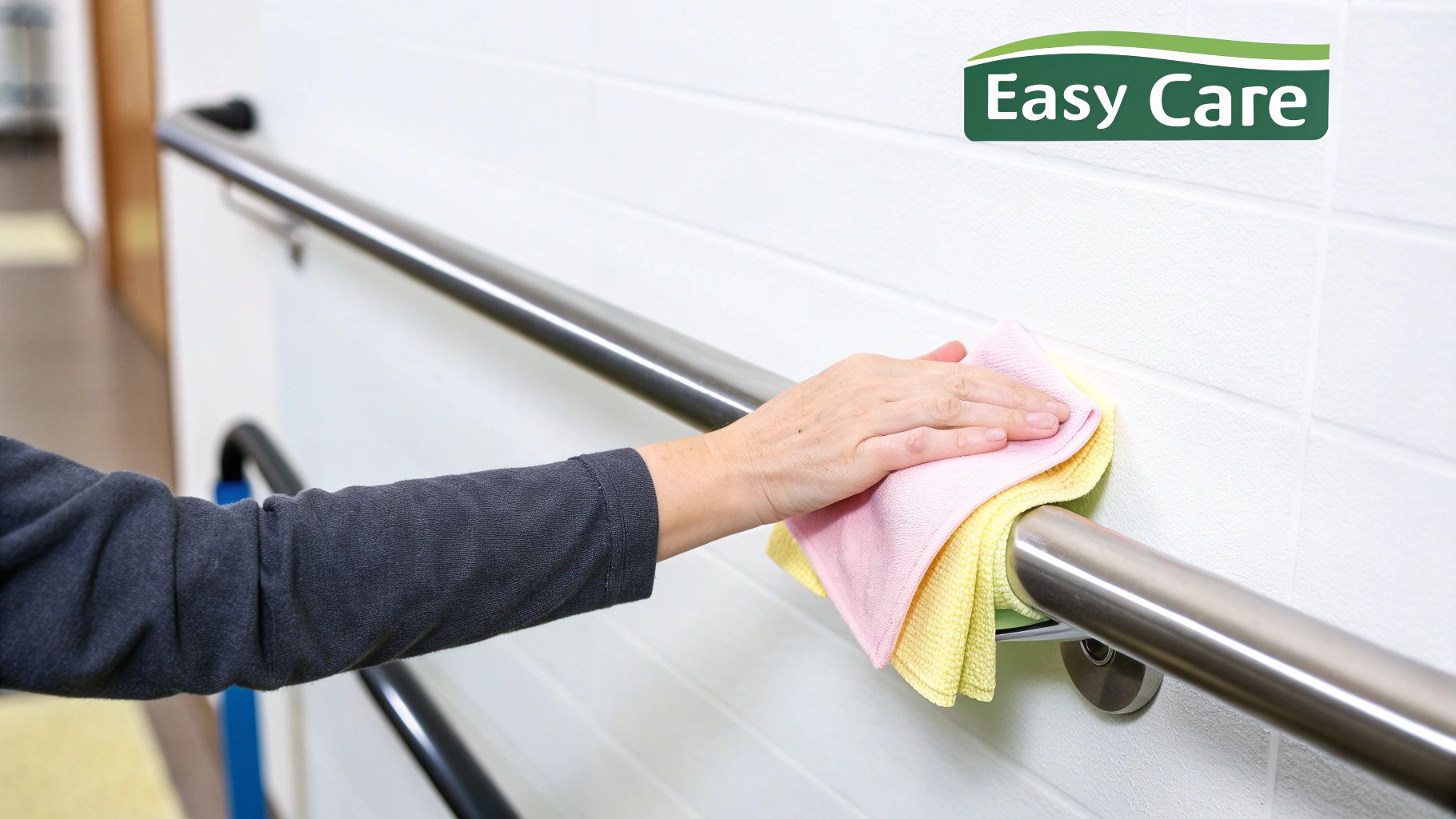
Choosing a clothes rail wall mounted for your laundry isn't just about saving a bit of floor space. It’s a genuine step towards a more sustainable way of living. When you decide to air-dry your clothes, you're making a real difference to your energy bills and your home's environmental footprint.
Think of your tumble dryer like the gas-guzzler of your home appliances. It eats up a huge amount of electricity with every single cycle, directly contributing to your carbon emissions. A wall-mounted rail, on the other hand, is the silent, zero-emission hero, powered by nothing more than the air in your home.
The Financial and Fabric Benefits
The first thing you’ll notice? A welcome drop in your electricity bill. Just by swapping a few dryer cycles for air-drying each week, you can rack up some impressive savings over the year. It's a simple habit change that pays you back.
But it’s not just about the money. Air-drying is so much kinder to your clothes. The harsh, tumbling heat of a dryer can cause your favourite fabrics to shrink, fade, and wear out far too quickly.
A wall-mounted rail gently air-dries your garments, keeping the fibres intact and helping them last much longer. This not only keeps your clothes looking great but also means you're buying replacements less often—another win for your wallet and the planet.
This move towards greener laundry habits is part of a bigger picture. The UK is actually one of the leading markets for energy-saving drying methods, showing that more and more of us are thinking about our environmental impact at home.
A Healthier Home Environment
Believe it or not, using a wall-mounted rail can also improve the air quality inside your home. Tumble dryers often release tiny microplastics and lint into the air, while natural drying is a completely clean, passive process. To get the best results, you can even find handy tips on detergents, additives, and drying methods for freshness to make sure your air-dried clothes smell amazing.
If you're ready to set up your own efficient drying station, our guide on installing a wall hanging rail has all the practical advice you need. By making this simple switch, you're doing more than just hanging up laundry; you’re actively choosing a greener, more economical, and healthier way to live.
Your Questions, Answered
When you're looking to install a wall-mounted clothes rail, a few questions always seem to pop up. Getting clear answers before you start is the difference between a successful project and a frustrating one. Let's walk through some of the most common queries I hear, so you can choose the right rail and install it with total confidence.
Think of this as a pre-installation chat to clear up any doubts. From how much weight a rail can really take to where on the wall it should go, we’ve got you covered.
How Much Weight Can a Wall-Mounted Clothes Rail Hold?
This is a great question, and the honest answer is: it depends. The rail's strength comes down to two things – what it’s made of, and more importantly, how it's attached to the wall. A chunky, industrial-style steel pipe rail might be rated to hold over 50kg, but that number only means something if you've anchored it into solid brick, concrete, or directly into the wooden studs inside your wall.
If you’re fixing it onto plasterboard, you have to be realistic. With the right heavy-duty fixings, you can expect it to hold around 15-20kg. Always have a look at the manufacturer's own guidelines, and think about the weight of your bulkiest items, like winter coats, before you start loading it up.
The golden rule is simple: a rail is only ever as strong as its weakest point. A super-strong rail with the wrong screws in a weak wall is a recipe for disaster.
Can I Install a Clothes Rail on a Plasterboard Wall?
Yes, you absolutely can, but you have to do it properly. Standard screws and those little plastic plugs you get in DIY kits just won't cut it here. They’ll pull straight out of the plasterboard as soon as you put any real weight on the rail.
The best-case scenario is always to find the wooden studs running behind the plasterboard (a simple stud finder will be your best friend here) and drive your screws directly into that solid timber. If the studs aren't in the right place for your rail, you'll need to turn to specialist plasterboard fixings.
A couple of reliable options are:
- Spring Toggles: These clever fixings have little 'wings' that spring open once they're through the plasterboard, spreading the load over a much wider area.
- Self-Drilling Metal Anchors: These are much tougher than plastic versions. They chew their own thread into the plasterboard, giving you a far more secure grip.
For a safe and long-lasting installation on plasterboard, using one of these is non-negotiable.
How Do I Stop My Wall-Mounted Rail from Rusting?
Stopping rust starts with choosing the right rail for the right room. If your clothes rail wall mounted is going somewhere with a bit of humidity – think a bathroom, or a utility room where you hang damp laundry – then the material is everything.
Look for stainless steel, galvanised metal, or a rail with a tough powder-coated finish. That powder coating acts like armour, sealing the metal from moisture and stopping rust in its tracks. For those cool, raw metal rails in a bedroom or hallway, you can add a layer of protection by wiping on a clear metal sealant. A simple habit of wiping the rail down if you hang anything damp on it will also go a long way.
What Is the Best Height to Mount a Clothes Rail?
There’s no magic number here – the perfect height is all about what you plan to hang. It needs to be tailored to your wardrobe.
That said, here are a few solid starting points:
- For Long Garments: If you want to hang long dresses, coats, or all-in-ones without them crumpling on the floor, aim for a height of 165-180cm.
- For Shorter Items: For a rail that will hold shirts, tops, and trousers folded over a hanger, 100-120cm from the floor is usually plenty.
- For Double Hanging: To create two tiers of storage, you could mount the top rail at around 205cm and the bottom one at 100cm. This leaves enough room for clothes on both levels without them overlapping.
Before you even think about drilling, do this one simple check: grab your longest piece of clothing on its hanger and hold it up against the wall where you plan to install the rail. This two-second test guarantees you'll get the height perfect the first time.
Ready to find the perfect storage solution for your space? Explore the high-quality, durable range of garment rails and display essentials at Display Guru. https://www.displayguru.co.uk


